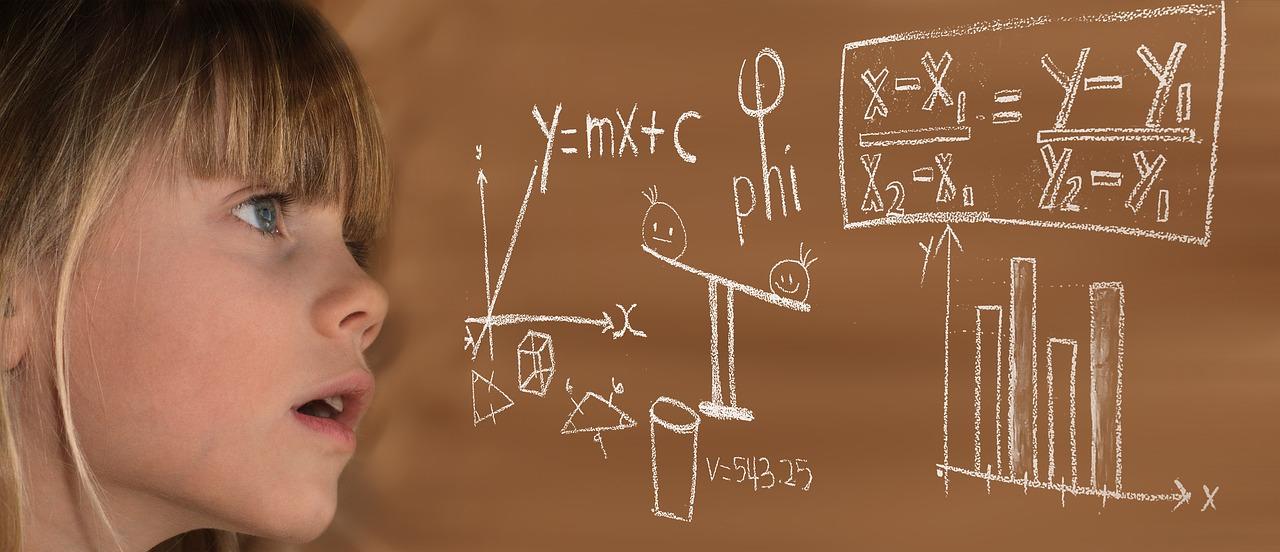Maths is always around us, everywhere we go!
There is no object in existence that is not somehow the outcome of maths. Everything within the universe, including humans, is part of a mathematical structure and all matter made up of particles has mathematical properties. In this sense, we can affirm that all the universe phenomena could be understood or studied through this fascinating science. As the famous astronomer, Galileo Galilei established: "The universe is written in the language of mathematics."
But what exactly is the language of Mathematics? Maths is expressed through a formal symbolic language and a mathematical notation, a system of symbolic representations of objects and ideas. This figurative language represents a concept, a relationship, or a mathematical formula according to specific rules. It is used in mathematics and other related sciences such as physics, engineering, and economics.
Now, to establish the procedures to solve or analyze all the factors involved in a mathematical problem, we use algebraic language. The algebraic language is the one that allows expressing mathematical relationships and helps us frame the operations that must be carried out in the form of equations. The elements that make up the algebraic language in the form of equations can be numbers, letters, or other types of mathematical operators.
The use of equations is crucial to solving different mathematical, geometric, chemical, physical, or any other problems, which have applications both in everyday life and in the research and development of scientific projects. You even knew that solving mathematical equations helps develop the intellect's creative capacity and helps solve daily life problems more quickly? Let's put that mind to work!
Did you know of complex equations with many unknowns and radical mathematical theorems dating back to ancient times? Let's go back a few centuries ago to see the origin of some of the equations that shaped our world and discover some of them that remain a mystery today!
Learn about mental mathematics class here!


Get to know some History of Equations!
Did you know that mathematicians already knew how to solve equations in ancient Mesopotamia and Babylon? In the sixteenth century BC, Egyptians developed an algebraic system based on hieroglyphs used mainly in everyday life tasks. Around this time, both the Babylonians and Egyptians were aware of the number π (pi), the ratio of a circle's circumference to its diameter. By about 1500 BC, the Babylonians were also aware of Pythagoras' theorem, which shows how the lengths of the sides of right-angled triangles are related.
But they were not the only ones! Around the 1st century AC, the Chinese also developed various methods for solving equations. And for example, the Greek mathematicians were the ones who created the first linear equations and the first to introduce algebraic symbolism.
In 1687, Newton published his law of universal gravitation, which states that two bodies in space pull on each other with a proportional force to their masses and the distance between them. And this was groundbreaking because it showed not just that abstract mathematical principles, such as the newly invented calculus, could be applied to what we observe in nature, but that the laws responsible for the movement of the planets are also responsible for the movement of objects on Earth, MINDBLOWING! Newton also believed that the universe could be understood as a mathematical object and described God as "skilled in mechanics and geometry."
Newton's contemporary, Leibniz, discovered another link between mathematics and nature when he first considered the idea of fractals. Twentieth-century mathematicians, such as the French mathematician Gaston Julia and the Polish-French-American mathematician Benoit Mandelbrot, were inspired by Leibniz to create complicated fractals.
By this time, quantum mechanics, and German-Swiss-American physicist Albert Einstein's theories of special and general relativity, had shown that nature obeys the laws of mathematics. And we can express everything mentioned here in the form of equations, everything! Have you not thought that theorems and mathematical formulas exist and are waiting to be discovered? After all, maybe everything in nature is part of a conspiracy theory.
We will look at some of the most famous maths equations below!
Looking to excel in Maths? Search for an online math tutor!

Discover 10 Famous Maths Equations!
If you're wondering why mathematical equations are essential to understanding this abstract science, discover ten revolutionary formulas that will take your math education to the next level!
There is, of course, no end to the number of mathematical formulas and equations that exist (some might say the list is infinite!). Still, we will focus on some of the better-known algebraic equations, which will make you be perceived as the most interesting being on earth!
The famous Pythagoras' Theorem
This equation is undoubtedly one of the best-known theorems. Even years after your last maths class, its name springs quickly to mind sometimes. You may know it by heart (we are sure you do), but let's quickly recap: In a right-angled triangle, the square of the hypotenuse is equal to the sum of the square roots of the lengths of the other two sides. This theorem dates back to 530 BC, is one of the foundations of maths, and has contributed to its history ever since its discovery.
This equation was essential for understanding analytic geometry and trigonometry; indeed has shaped our understanding of those branches of mathematics. Pythagoras and his famous equation make it easy to calculate lengths angles and demonstrate that a given triangle is right-angled. However, did you know that the Babylonians knew the Pythagorean theorem way before the birth of Pythagoras? The Pythagorean theorem was first known in ancient Babylon and Egypt. This was revealed when a 4000-year-old Babylonian clay tablet showed an understanding of the Pythagorean theorem more than 1000 years before the birth of the Greek philosopher!
Click here to know more about the best mental mathematics class!
What's up with Logarithms?
Logarithms, popularised by John Napier in 1610, combine inverse and exponential functions and opposites. For those who are not the best at math (some of us included), we can easily define a logarithm as the power that must raise a specific number to get some other number. Logarithms are common in formulas used in science to measure the complexity of algorithms and fractals and appear in formulas for counting prime numbers.
Until the development of the modern computer, calculating with logarithms was the most usual way of multiplying large numbers together to make possible faster calculations. But above all, logarithms helped make leaps and bounds in maths, physics, engineering, and astronomy. For example, in the case of base 10, the logarithm (log) is: Log (1) = 0, log (10) = 1, log (100) = 2.
It is essential to remember that there are three types of logarithm:
- Natural logarithms are the fundamental basis in mathematical analysis.
- Decimal logarithms are used in mathematical calculations.
- Binary logarithms are used in computational theory and for applied calculations.
What to learn more about logarithms? Discover various waterloo Math courses on Superprof!
Is there a Law of Gravity?
Who has never heard of Isaac Newton's famous law of gravity? Do you remember the most famous apple incident? Isaac Newton discovered this law in 1666. Newton conceived his law of universal gravitation when he was resting under an apple tree. While this was happening, the fall of an apple made him reflect on the possible causes that provoked it. But Newton then wondered: Why does the moon not fall from the sky? The answer is obvious: It is "held up" by a gravitational force.
Newton's famous law of gravity states: "Astral bodies attract each other with a force that is directly proportional to the product of their masses and inversely proportional to the square of the distance between their centers."
However, two hundred years after Newton, Einstein replaced this theory of gravitation with his theory of relativity, which would be quickly adopted by all the great centers of thought and study of physics and maths in the world.

Einstein's Theory of Relativity
Whether one is versed in mathematics or physics or knows nothing of maths vocabulary, everyone knows Albert Einstein's famous formula: E = mc². This formula, which illustrates the theory of relativity (restricted and general relativity), revolutionized our understanding of the exact sciences.
Einstein's general theory of relativity states that gravity is not a force (Newton) but the curvature of space-time. Restricted relativity introduced the idea that the speed of light was a universal constant that did not change and that the passage of time was not the same for bodies moving at different speeds. Einstein's theory of relativity remains essential in understanding our universe's origin, structure, and destiny. Are you aware of how maths helps us better understand the world around us and is an omnipresent force in our daily lives?
What is the Chaos Theory?
The chaos theory has shown us that it's impossible to predict what will happen in the future. This theory proves that existing processes may not be predicted with certainty. It is the study of apparently random or unpredictable behavior in systems with deterministic laws and a great topic to learn maths!
Robert May's theory dates from 1975, and it describes a process that is constantly evolving. In his formula, May wanted to explain that chaotic behavior (such as climate, which experiences numerous changes in weather from moment to moment) can lead to changes in other completely different systems a few days later.
The best-known illustration is the so-called "butterfly effect," which shows that the beating of a butterfly's wings in Brazil can lead to a hurricane or tornado in Asia. In other words, the most insignificant of things can have unsuspected effects on the environment. The multiplicity of factors related to an event makes it unpredictable.
The essential e^(iπ)+1=0
This formula is better known as Euler's identity. It is considered "one of the finest equations" in maths because it describes an unlikely combination of five mathematical constants. Euler's formula is used in geometry to determine the relationship between the faces and vertices of polyhedra. And in trigonometry, it is used for tracing the unit circle.
Leonhard Euler published Euler's equation in 1755, and it is essential because it uses three fundamental operations in arithmetic: addition, multiplication, and exponentiation. The five constants represented are "0", the additive identity; "1", the multiplicative identity; the great π (pi); "e" which is the base of natural logarithms and a number which widely occurs in mathematical analyses; and "I," the imaginary unit of the complex numbers found in equations with three unknowns.
This equation paved the way for the development of topology, another branch of modern maths.
Get to know the Fourier Transform!
The Fourier transform divides time into several frequencies and simple waves, just as a prism splits light in its constituent colors. In other words, it gives us the ability to understand the frequencies inside a signal. The Fourier transform allows us to deal with non-periodic functions.
This theory was so earth-shaking because, suddenly, it was possible to understand the structure of more complex waves, such as human speech. Today, this theory, which dates back to 1822, goes to the heart of modern signal processing and analysis and data processing. One of the most significant advantages of the Fourier transform is that it uses all parts of the waveform to translate the signal into the frequency domain.

What are Maxwell's Equations?
Maxwell's equations describe how electric charges interact and explain electric currents and magnetic fields. Maxwell's equations, also called Maxwell-Lorentz equations, are fundamental laws of physics. They underpin our understanding of the relationship between electricity and magnetism, essential in modern physics and fundamental laws. There are four forms of Maxwell's equations:
- The Maxwell-Gauss equation
- The Maxwell-Thomson equation
- The Maxwell-Faraday equation
- The Maxwell-Ampere Equation
Discover more about Maxwell's Equation with the best online Math tutors on Superprof.
Explaining the Second Law of Thermodynamics
The second law of thermodynamics (also known as the Carnot principle after its discoverer, in 1824) proves that physical phenomena are irreversible, mainly when thermal changes occur. This principle has been modified and reformulated on several occasions and gained widespread popularity in 1873, thanks to Ludwig Boltzmann and Max Planck.
While the first law of thermal dynamics specifies that energy can be exchanged between physical systems as heat and work, the second law introduces another quantity, known as entropy. Entropy refers to the amount of energy unavailable to do work, and it is associated with a state of disorder or uncertainty.
The second law of thermodynamics is a principle of change and evolution since it determines in which direction potential energy transformations are possible. All the processes in the universe are carried out so that disorder always increases and, therefore, entropy. Consequently, some chemical transformations are possible while others will never be. You can state with certainty, for example, that if you put an ice cube in a cup of hot coffee, the ice cube will melt, while the coffee will never freeze (great example, eh?).
The Schrödinger Equation Explanation
The Schrödinger equation, conceived by the Austrian physicist Erwin Schrödinger in 1925, is a fundamental equation in quantum mechanics. As Einstein's theory of general relativity helped explain the universe on a large scale, this equation sheds light on the behavior of atoms and subatomic particles.
The Schrödinger equation explains the changes over time of a particle. We can find the application of this equation in modern technology, including nuclear energy, solid-state computers, and lasers since its solution is related to the probability density of a particle in space and time.
As we can see, throughout human history and significantly since the 18th century, mathematical equations have transformed our understanding of the world in which we live and our ability to solve maths problems. Do you want to gain more insights into algebraic equations, the quadratic formula, simultaneous equations, differential equations, polynomial equations, linear equations, exponential function, and systems of equations? Check for the most practical online math courses here!
Do you want to learn more about Maths? Click here!

Get to know Important Maths Prizes And Awards
There are several integral awards given to people, often nicknamed geniuses, who excel in various areas of mathematics, that usually offer a solution to a math problem. These are prestigious awards with absolute value and worth, some of which are equivalent to winning the Nobel Prize. Only a very select few receive these awards highlighting their mathematical excellence.
- The Fields Medal
The Fields Medal is one of the most famous prizes given to mathematicians who have achieved something extraordinary during their careers, such as discovering significant maths or related theories.
Officially, winners of this prize are awarded the International Medal for Outstanding Discoveries in Mathematics (you can see why this is more commonly referred to as simply the Fields Medal), and it is only given out once every four years. The award's name is in honor of the Canadian mathematician John Charles Fields.
- The Abel Prize
The King of Norway presents the Abel Prize to a mathematician who is outstanding in the field. It is named after Niels Henrik Abel, a famous Norwegian mathematician. For developing a program connecting representation theory to number theory, the Canadian mathematician Robert Langlands won the prestigious Abel Prize on May 22, 2018.
- Wolf Prize in Mathematics
The Wolf Foundation of Israel awards six different prizes each year, one of which being the Wolf Prize in Mathematics. This award has been in existence since 1978 and is a great honor to the nominee. The Canadian University Professor James Arthur was awarded the highly prestigious Wolf Prize in Mathematics. However, another recognized Canadian has won the mathematics prize too. The first to win it was Robert Langlands, who was Arthur's graduate supervisor at Yale. Get to know more here!
- The Chern Medal
One of the newer prizes in mathematics is the Chern Meda, which has been recognizing lifetime achievements for maths since 2010.
It is awarded every four years, so only a handful of mathematicians have gotten their hands on one of these prestigious awards, which includes a monetary prize of $250,000 (evidently to help fund further research or enhance tuition in other fields of mathematics). The first recipient in 2010 was Louis Nirenberg, and the 2014 winner was Phillip Griffiths.

Taking Mathematics Into The Future
What will be the next major mathematical innovation? What new mathematical revelation will overturn our current conceptions of life as we know it? Could you become a renowned mathematician for a quadratic equation, an algebraic function, a trigonometric breakthrough, or even for discovering a new concept like the Pythagorean theorem?
Alternatively, maybe you will bring something new to the table by discovering a new integer we never knew existed, developing an intellectual graphing calculator, or simplifying maths with an equation solver device or a system of equations app. The truth is that from now on the mathematical sciences will continue to be impacted by all the disruption caused by all the technological advances, and if you are willing to take this path is something you must consider!
Are you thinking about excelling in maths equations? Find the best private maths tutor with Superprof, the complete online platform of private tutoring. Don't forget, Superprof can help you find the perfect math tutor if you become inspired to get extra online school help through face-to-face or online lessons!
Do you want to boost your maths skills to win every poker game or solve any puzzle? Find the perfect mathematics class for you just here!
Welcome to the Superprof family!
















